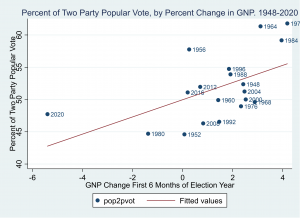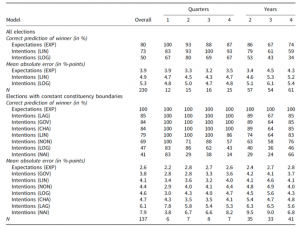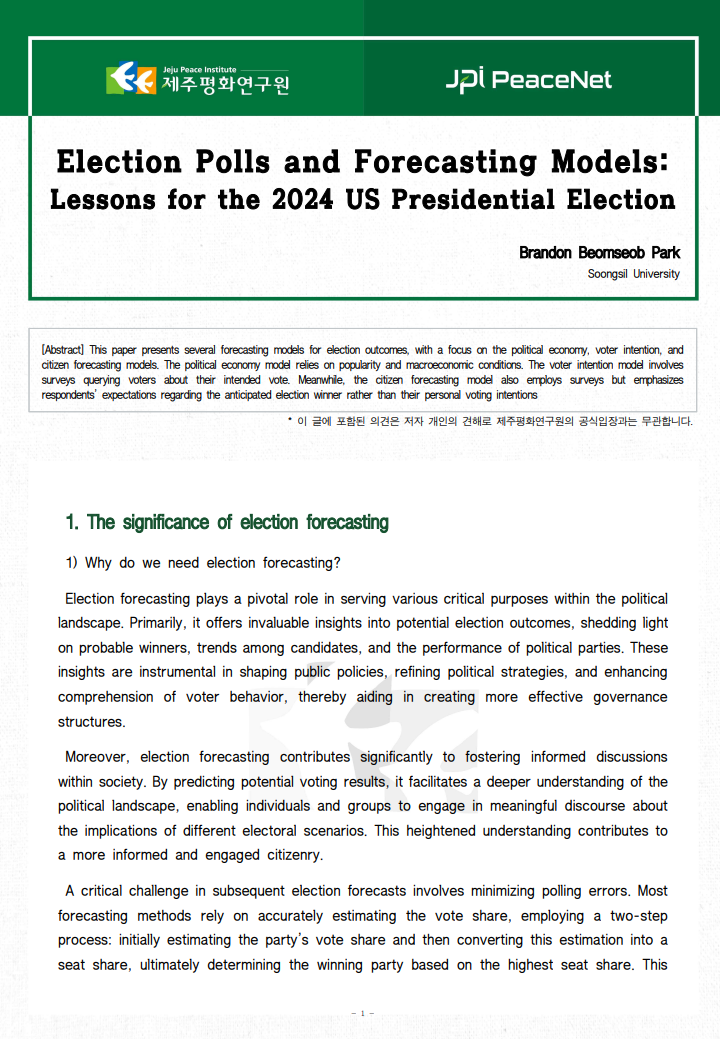[Abstract] This paper presents several forecasting models for election outcomes, with a focus on the political economy, voter intention, and citizen forecasting models. The political economy model relies on popularity and macroeconomic conditions. The voter intention model involves surveys querying voters about their intended vote. Meanwhile, the citizen forecasting model also employs surveys but emphasizes respondents’ expectations regarding the anticipated election winner rather than their personal voting intentions.
1. The significance of election forecasting
1) Why do we need election forecasting?
lection forecasting plays a pivotal role in serving various critical purposes within the political landscape. Primarily, it offers invaluable insights into potential election outcomes, shedding light on probable winners, trends among candidates, and the performance of political parties. These insights are instrumental in shaping public policies, refining political strategies, and enhancing comprehension of voter behavior, thereby aiding in creating more effective governance structures.
Moreover, election forecasting contributes significantly to fostering informed discussions within society. By predicting potential voting results, it facilitates a deeper understanding of the political landscape, enabling individuals and groups to engage in meaningful discourse about the implications of different electoral scenarios. This heightened understanding contributes to a more informed and engaged citizenry.
A critical challenge in subsequent election forecasts involves minimizing polling errors. Most forecasting methods rely on accurately estimating the vote share, employing a two-step process: initially estimating the party’s vote share and then converting this estimation into a seat share, ultimately determining the winning party based on the highest seat share. This procedural approach introduces potential errors stemming from two sources: the estimate of vote intentions and the subsequent transformation of that estimate into seats.
In a recent compilation of existing forecasting studies investigating the 2015 election, the majority of academic teams followed the two-step process of estimating vote shares before converting them into seat shares. However, there was an exception where only one forecasted seats directly. This deviation from the usual methodology resulted in relatively more precise seat share predictions for the Conservative and Labour parties, as indicated in the work by Fisher and Lewis-Beck (2016) and Murr (2016). This shift in approach highlights the potential for increased accuracy in seat share predictions when bypassing the intermediate step of estimating vote shares separately (Murr 2021).
2) What are the main issues?
When engaging in the art of forecasting, several critical factors must be considered for an effective prediction. Accuracy stands as a pivotal benchmark, signifying the proximity of the forecast to the eventual outcome, whether it’s in terms of seat allocation or vote shares. A forecast’s credibility increases with its proximity to reality. The temporal aspect, encapsulated by the lead time, also plays a crucial role, where forecasts made farther in advance tend to offer a more comprehensive view of potential outcomes. Parsimony acts as another guiding principle, advocating for simplicity by favoring models with fewer predictors or streamlined methodologies, as they often yield clearer insights. Additionally, the principle of reproducibility comes into play, emphasizing the importance of cost-effective methods that allow for easy replication, enhancing the reliability and trustworthiness of forecasts over time. These factors collectively form the bedrock of effective forecasting, providing a framework for informed and reliable predictions.
2. Various Models in Election Forecasting
1) Political Economy Model
One of the earliest political science forecasting methods, dating back several decades, revolves around a theory-driven approach deeply rooted in fundamental political and economic issues. This method relies on analyzing historical data, societal trends, and core political and economic indicators to generate forecasts. By considering factors such as incumbent popularity, economic indicators like GDP growth or unemployment rates, and geopolitical circumstances, this approach estimates election outcomes well in advance of the actual voting day. By intertwining theoretical underpinnings with empirical data, this method strives to provide an insightful and predictive understanding of election results, making it a pioneering and enduring technique in political science forecasting. Figure 1 presents the bivariate relationships between the economy and vote share, and between the popularity and the vote share, indicating a strong and positive association.
Incumbent Vote = Presidential Popularity + Economic Growth + e


Figure 1: Bivariate Associations between Votes and Economy and Approval
When scholars make election forecasting, there are two important factors: presidential approval rate and the economic situation of the country. If we take a look at the U.S. national conditions for the 2024 Presidential Election, Biden’s job approval rate is decreasing, and it is not creating a favorable outlook. His approval rate started with 56% right after he began his job in the office, but as of December 2023, his approval rate is fluctuating around 40%. Regarding the U.S. economy, major indexes are improving but the electorates are not seeing the economic recovery, yet.
2) Vote Intention Model
Vote intentions represent an individual’s understanding and stance on their personal preferences regarding a particular election. On the other hand, voter expectations, also known as citizen forecasting, inquire about an individual’s perception of who they believe will win the upcoming general election, regardless of their own voting inclinations. This perspective reflects not only personal opinions but also incorporates insights garnered from the broader community, gathered from sources such as family, friends, casual discussions in public places like pubs or while commuting on a bus (as noted by King et al. in 2001).
3) Vote Expectation Model (Citizen Forecasting)
Vote intentions represent an individual’s understanding and stance on their personal preferences regarding a particular election. On the other hand, voter expectations, also known as citizen forecasting, inquire about an individual’s perception of who they believe will win the upcoming general election, regardless of their own voting inclinations. This perspective reflects not only personal opinions but also incorporates insights garnered from the broader community, gathered from sources such as family, friends, casual discussions in public places like pubs or while commuting on a bus (as noted by King et al. in 2001).
According to research by Leiter et al. (2018), citizens’ social networks play a pivotal role in election forecasting. This is because voter expectations capture information not just from the respondent but also reflect the collective knowledge and opinions within their social circle. Unlike vote intentions that solely focus on the individual respondent, citizen forecasting considers the broader perspectives and discussions circulating within the community, providing a nuanced understanding of the prevailing sentiments and expectations about the election outcome.
4) Vote Intention vs Vote Expectation
A set of empirical evidence shows that vote expectation models predict better compared to vote intention models. Why might vote expectations be more accurate predictors compared to vote intentions? According to Murr (2017) and Leiter et al. (2018), a significant factor contributing to this difference lies in the incorporation of information from citizens’ social networks within vote expectations. The inquiry, “who will win?” allows individuals to relay information gathered from their interactions with family, friends, and even casual settings like social gatherings or public transportation (as noted by King, Wybrow, and Gallup in 2001: 1f).
Leiter et al. (2018), through a German survey, discovered that attributes of citizens’ social networks such as size, political inclinations, and the frequency of political discussions, stand among the most influential variables when predicting election outcomes. It stands to reason that inquiries regarding vote expectations tend to provide more accurate predictions for election results. This is because such questions capture information not only about the respondent but also encompass insights from their social network, in contrast to vote intentions that solely focus on the respondent’s individual stance (Murr 2021).
<Table 1: Forecasting accuracy of both models>

Source: Murr et al. 2021(64)
When looking at British General Elections results, forecasting accuracy of voter expectation models outperformed voter intention models. Among all elections between 1987 and 2017, voter expectations model predicted correctly for 80% of the time whereas the best voter intentions model yielded correct prediction of winner for about 73% and the worst model for 50%.
Lead Time
The tension between proximity to the election and forecast accuracy is a common challenge in forecasting models. Generally, conventional wisdom suggests that forecasts closer to the election tend to be more accurate. Table 2 presents accuracy measures for forecasting models across the four years leading up to the election, with the year before the election divided into quarters.
<Table 2. Forecasting accuracy in the quarters/years before the election>

Source: Murr (2021:65)
The data in Table 2 illustrates a consistent trend: as the years until the election decrease, forecasts tend to become more accurate. However, it’s noted that when the forecast occurs right before the election, its accuracy might be considered trivial. The lead time significantly impacts the quality of the forecast, as mentioned by Lewis-Beck in 2005, stating that providing a substantial horizon of six months to a year leads to impressive forecast performance.
Interestingly, upon analyzing the results one year before the election, quarter by quarter, the trend of accuracy ceases to exhibit a straightforward decline. Specifically, for the critical dependent variable, CPW, two models achieve perfect scores: Q1 for EXP and Q3 for LIN, showcasing exceptions to the general trend and highlighting instances where accuracy remains notably high despite the decreasing lead time to the election.
3. The 2024 U.S. Presidential Election Forecasting
Scholars expect that the results of the 2024 U.S. presidential election will be determined by the state of the U.S. economy in the first half of next year. Whether and how much U.S. voters’ perceptions of the Biden administration’s economic performance can improve during the first half of 2024 will play a vital role in shaping the outcome of next year’s election. For example, if the U.S. inflation situation gradually improves over the first half of next year, and the U.S. electorate sees this change, along with a rise in President Biden’s job approval ratings, the presidential election outcome will be formed in his favor. Otherwise, the tide will turn in favor of the Republican presidential candidate.
Assuming a rematch between Mr. Biden and Mr. Trump in the 2024 presidential election, it is expected that forecasting using the data in the second half of next year will produce more accurate on predicting which candidate will emerge victorious. Typically, when an incumbent president seeks re-election, the electoral environment is more favorable to the incumbent, as they have an incumbency advantage, meaning they have access to campaign resources, the ability to raise money for the campaign and so on. In the case of next year’s presidential election, the incumbency advantage for Mr. Biden is unlikely to be significant, as Mr. Trump, who has just finished his term, is running. In addition polling results for both candidates show support for both candidates fluctuating within the margin of error, making it difficult to say which candidate is ahead at the moment.
In conclusion, election forecasting has demonstrated its effectiveness even at considerable lead times before an election. In the realm of polling, there’s an interesting trend where Voter Expectations tend to outperform voter intentions in terms of predictive accuracy.
For instance, asking individuals, “Who do you think will win the 2024 U.S. presidential election?” rather than inquiring about their personal voting intentions, can yield compelling insights. In an experiment conducted at the end of April, serving as an initial gauge for the 2024 election, the results indicated a highly competitive race between Biden and Trump, provided these findings are consistent and hold true over time.
This approach taps into citizen forecasting or Voter Expectations, which often incorporates a broader scope of information gleaned from social circles and prevailing sentiments within communities. These early indicators suggesting a tight contest between the mentioned candidates emphasize the potential reliability and relevance of Voter Expectations as an effective tool for forecasting election outcomes even at an early stage of the electoral cycle.
—————————————————————————————-
<Reference>
- Fisher SD and Lewis-Beck MS (2016) Forecasting the 2015 British general election: the 1992 debacle all over again? Electoral Studies 41(1), 225–229
- King A, Wybrow RJ and Gallup A (2001) British Political Opinion, 1937–2000: The Gallup Polls. London: Politico’s Publishing.
- Leiter D et al. (2018) Social networks and citizen election forecasting: the more friends the better. International Journal of Forecasting 34(2), 235–248.
- Murr, Andreas, Mary Stegmaier, and Michael S. Lewis-Beck. 2021. ‘Vote Expectations versus Vote Intentions: Rival Forecasting Strategies,’ British Journal of Political Science. 51:60-67.
- Murr AE (2016) The wisdom of crowds: what do citizens forecast for the 2015 British general election? Electoral Studies 41 (1), 283–288
- Murr AE (2017) Wisdom of crowds. In Arzheimer K, Evans J and Lewis-Beck M (eds), The Sage Handbook of Electoral Behaviour. London: Sage, pp. 835–860.
이 글에 포함된 의견은 저자 개인의 견해로 제주평화연구원의 공식입장과는 무관합니다.
편집 : 김수연 연구원
박범섭 (숭실대학교 정치외교학과 교수)
박범섭 교수는 숭실대 정치외교학과에서 근무하고 있다. 한동대학교에서 학사를 취득 한 후, 런던정경대(LSE)에서 국제정치학 석사를, 베를린경제대(BSE)에서 국제경제학 석사를 취득한 뒤, 미국 미주리대학교에서 비교정치학으로 박사학위를 취득하였다. 이후 뉴저지주립대(The College of New Jersey), 영국 레딩대학교(University of Reading)에서 가르치다가 2022년 숭실대로 왔다. 주 연구분야는 선거이다.
